*Config Helper is displayed when creating a new site. Its purpose is to speed up the initial setup for a site.
Although Config Helper works for many sites, not every site can be configured this easily, meaning that certain
sites may require a manual and more elaborate setup. Even for those sites, you can try to create the basic
configuration with Config Helper and then modify the site settings later. Additionally, it is possible to exit
Config Helper any time or disable Config Helper entirely.
It’s all about CSS selectors and you can learn how to use them in minutes by watching the introduction tutorial. The plugin’s Visual Inspector tool also helps you find CSS selectors easily by clicking onto the elements in the target sites. Here is the gist of it:
Here is the list of some features of WP Content Crawler. To learn about all of the features, please see the features table below.
HTML code of social media posts existing in the target post page is automatically converted to short codes. By this
way, they are displayed on the front end of your website correctly. Additionally, all the iframe elements are
converted to a short code. An iframe short code is displayed only if its source is trusted. If the source of an
iframe is not trusted by default, you can manually add a trusted domain so that the iframe is displayed. With this
method, you can display media from third-party sites securely. Websites whose media are embedded automatically
include Instagram, Imgur, YouTube, Vimeo, TikTok, Kickstarter, Twitter, Pinterest, and so on.
Save every post detail
Title, excerpt, content, tags, categories, slug, date, custom meta, taxonomies, meta keywords, meta description, featured image, post images, status… Just everything.
|
|
Visual Inspector
Just click to an element to find its CSS selector. You can also get alternative CSS selectors that you might be interested in. There is no need to leave your admin panel anymore.
|
| |
|
|
Crawl (scrape, grab, save) posts
After the settings are configured, the plugin finds URLs of the posts and crawls them automatically in the background.
|
|
Recrawl (update) posts
Recrawl posts automatically to keep them updated all the time. You can limit how many times a post can be updated, set update interval, and ignore old posts.
|
| |
|
|
Delete posts
You want to delete old crawled posts? The plugin can delete them automatically.
|
|
Control scheduling
You can set how many times URL collection and post crawling events should run each time for a site. For instance, you can save 3 posts every minute, or run URL collection 5 times every 2 minutes.
|
| |
|
|
Save categories
The target category does not exist in your site? No problem. The plugin can create the target categories for you. Just define the CSS selectors that find category names. They can even be created as subcategories.
|
| Save slugs (permalink)
You can define the permalink of the posts. You can get the permalink from the target site, enter custom text, and even create templates for the slugs by using short codes.
|
| |
|
|
Save taxonomies
Save taxonomy values by retrieving them from the target site or entering manually. Saving details of custom post types is easier than ever.
|
|
Save posts into custom categories
A custom post type has custom categories? No problem. You can define custom category taxonomies used by the custom post type and select those categories when defining the categories of the post. The plugin can also create custom categories for you.
|
| |
|
|
Custom post meta
Save anything as custom post meta. You can use a CSS selector or just type the value.
|
|
Content templates
Prepare post content, title, excerpt, list item and gallery item templates using short codes. Moreover, you can define templates for values of each CSS selector using the options box.
|
| |
|
|
Alternative selectors
You can write alternative selectors to get the data even if the target site has post pages designed differently from each other.
|
|
Find and replace anything
You can use plain text or regular expressions to find and replace anything. You can even modify the HTML of the page, create your own HTML elements and write selectors to use them. You can even change image URLs. You have the power.
|
| |
|
|
Paginated posts
Target post has more than one page? No worries. You can save paginated posts as well.
|
|
List type posts
Some sites create posts with a list inside. You can extract the list from the post, create a template that should be applied to each list item and even reverse the list.
|
| |
|
|
Remove unnecessary elements
Sometimes you need to get rid of some elements, such as advertisements, comments, you name it. Just write its CSS selector and it is removed.
|
|
Automatically insert category URLs
Target site has hundreds of categories? Piece of cake. Just write the CSS selector and the plugin will insert them for you.
|
| |
|
|
Post types
Set post type. It can be a post, a page, a product, or any other post type available in your WordPress installation.
|
|
Remove links
You can remove links from the post. Just check the checkbox and the links are gone. That easy.
|
| |
|
|
Password protection
You can set a password for the posts to show them only to the users who have the password.
|
| Notes
You can add notes for yourself to remind you things about the site. CSS selectors, TODO list, anything.
|
| |
|
|
Test everything on the fly
Test post crawling, URL collection, CSS selectors, regular expressions, find and replace options and proxies on the fly. You can also enable caching to perform the tests much faster and reduce the requests sent to the target site.
|
| Test all the settings of a site at once
Using the tester, you can test all options you configured in the site settings to make sure everything works as you want before enabling automatic crawling.
|
| |
|
|
Tools
Using the tools, you can save posts manually with their URL, recrawl posts with their ID or delete already-saved URLs.
|
| Custom general settings for each site
You can provide custom general settings for each post to override them and make them suitable for a site.
|
| |
|
|
Post status
You can directly publish the saved posts or keep them as draft to check them before publishing.
|
| Save all images in post content
Saving all images in the content of the post is as easy as checking a single checkbox.
|
| |
|
|
Save images as gallery
You can save the images in the target page as gallery and provide a template for each image to make it suitable for the gallery library that you use on frontend. You can also save the images as WooCommerce gallery by just checking one checkbox.
|
| Any data as short code
Get anything from target page as a short code and use the short codes in the plugin’s templates to place any data anywhere you want.
|
| |
|
|
Proxy
Use a proxy or proxies to get content from the sites to which your IP does not have access.
|
|
Cookies
Attach cookies, such as session cookies, to each request. By this way, for example, you can crawl the target site as if you are logged in.
|
| |
|
|
Crawl as many posts as you want
You can set how many times post crawling or URL collection CRON events should run. By this way, you can, e.g., save 100 posts every minute. Just be careful and consider your server’s capacity.
|
| Email notifications
Set CSS selectors whose values should not be empty for category and post pages. When an empty value is found using those selectors, you can get an email notification.
|
| |
|
|
Get data from JSON
When you enable JSON parsing for a CSS selector, you can get the values from the JSON easily.
|
|
Advanced HTML manipulations
Find-replace in response HTML, find and replace in element attributes, exchange element attributes, remove element attributes, manipulate HTML of an element, remove HTML elements…
|
| |
|
|
Automatic translation
Use the artificial intelligence of DeepL Translate API, Google Cloud Translation API, Microsoft Translator Text API, Yandex Translate API (old) or Amazon Translate API to automatically translate the posts. Note that these are paid services. They generally offer the service for free for a limited amount of time. You can see their pricing pages to learn more.
|
| Automatic spinning
Use spinning to automatically rewrite crawled posts’ contents to improve search engine optimization. The plugin currently implements Spin Rewriter API and Turkce Spin API, which are paid services. You can visit their website to learn the pricing details.
|
| |
|
|
Duplicate post check
Check duplicate posts by URL, post title and/or post content. If you are using WooCommerce, products whose SKU already exists are considered as duplicate and they will not be added to your site.
|
| Scheduled posts
You can add/remove minutes to/from the post date. By this way, you can schedule post publishing.
|
| |
|
|
Save WooCommerce products
Save price, inventory, shipping, attributes, and advanced options. You can save the product as a simple or an external product. You can also set downloadable file options and define the product as virtual. The options are available for WooCommerce versions greater than or equal to 3.3.
|
| Options box
You have the control! Define many options for the values found by a CSS selector. The options include find-replace, calculation, template, and JSON parsing settings. You can easily import/export the options defined in the options boxes as well.
|
| |
|
|
Handle files like a pro
Rename, copy, and move saved files easily. You can also define title, description, caption, and alt texts for the saved media files using templates in which you can use any short code. It is also possible to give random names to the saved files.
|
|
Handle iframes and scripts like a pro
WordPress does not allow showing iframes and scripts since they pose a security risk. You can turn iframe and script HTML elements into short codes by just checking a checkbox. The short code will show iframes and scripts from the allowed source domains defined by you.
|
| |
|
|
Quick save
With quick save button, you can save the settings much more quickly. No need to wait for page to reload.
|
|
Regular expressions
Define regular expressions in find-replace options to find-replace anything. You can also use delimiters and modifiers to match more precisely.
|
| |
|
|
Save “srcset” attributes
When alternative sizes of the saved images are available, the plugin assigns them into srcset attribute of img elements so that your pages will load faster in different screen sizes.
|
|
Save “alt” and “title” attributes
When you save images, their “alt” and “title” attributes are automatically retrieved from the target site and assigned to the saved media. You can also define templates for them to apply your SEO strategies.
|
| |
|
|
Warnings
Learn when there is a problem. The plugin will show you the details of the error so that you can fix it right away.
|
|
Handle character encoding problems
The plugin is able to handle different character encodings, even if the target site contains mixed encodings. You can convert the encoding by checking a single checkbox.
|
| |
|
|
Navigate between settings easily
Fix navigation to the top! The plugin stores where you were before switching to a new tab and restores your previous location when you activate that tab again. No more getting lost among the settings.
|
|
Manual crawling tool
With manual crawling tool, save multiple posts by entering their URLs. You can also enter category URLs so that the tool can get post URLs from there. Moreover, you can set it to crawl multiple posts at the same time.
|
| |
|
|
Add URLs to the database
The plugin collects URLs automatically. However, if you want it to crawl only certain URLs, you can add them to the database manually using the manual crawling tool. By this way, the specified URLs will be crawled using your scheduling options, automatically.
|
| Enable/disable automatic crawling for a specific site
You can enable or disable automatic crawling for each site individually.
|
| |
|
|
Import/export
You can import and export site settings easily. Just copy and paste the code created by the plugin.
|
| Unlimited
Add unlimited sites to the plugin and activate how many of them you want.
|
| |
|
|
Detailed dashboard
See what’s going on in the background. Active sites, number of posts crawled, number of posts updated, last crawled and updated posts, last added URLs, last and next run of CRON events, currently being saved posts and URLs…
|
| Get updates from your admin panel
You can update the plugin with just one click whenever an update is ready. Just go to your updates page in your admin panel.
|
| |
|
|
Use the most secure PHP
The plugin supports the latest versions of PHP.
|
| Use the most modern browsers
The plugin supports Chrome, Firefox, Safari, Opera, and Edge.
|
| |
|
|
Interactive guides
Interactive guides show you how to configure settings to achieve certain things, step-by-step, like a living documentation. You can start these guides whenever you want. You can even start them from a specific step.
|
| Online documentation
You can check the online documentation whenever you feel a need.
|
Quick guides right next to the settings
Each setting in the plugin has a quick guide that will help you understand what each setting does.
|
| Video tutorials
Watch video tutorials to easily learn how to use the plugin.
|
| |
|
|
Ready to translate
You can translate the plugin into your own language using Poedit.
|
|
Filters
With filters, you can do things conditionally. For example, you can increase the price of a product if one
of its attribute values contains a specific word. Filters contain many action commands. See
the commands
in the documentation.
|
| |
|
|
Use OpenAI GPT (ChatGPT)
You can use OpenAI GPT models to change the title, content, tags, file names, and more. You can use GPT-3.5
and GPT-4. With the advanced short code builder, you can use the chat, complete, edit, and insert modes.
To learn more, watch this video!
|
|
Convert JSON to HTML
You can convert JSON data to HTML easily. Then, you can select them via CSS selectors, as they become HTML
elements. This makes it possible to retrieve content from websites that use modern JavaScript frameworks
that include all the page data as JSON.
Watch this video to learn more!
|
| |
|
|
Embed social media posts automatically
Posts from 70+ websites including Instagram, Facebook, Amazon, YouTube, Twitter, Scribd, Vimeo, Pinterest,
Spotify, Meetup, and many others are converted to embed short codes automatically. By this way, they are
displayed securely on the front end of your website!
|
| Make custom requests
You can make custom requests to other APIs or websites and include the response into the current page.
Watch this video to see how powerful this
feature is! This also makes it possible to retrieve content added to the page via AJAX.
|
One of the most distinctive features of WP Content Crawler is the ability to test almost any configuration. By this way, you will not come across any surprises after you enable automatic crawling. When testing, the errors related to your settings are shown so that you can fix them before they cause any problems.
WP Content Crawler has so many features that even we do not know how many of them are there. You can automatically crawl, update, and delete the posts, you can translate posts, spin posts, you can even define what fields need to be translated or spun if you do not want them all changed. You can find-replace almost anything. You can assign some information from the target post to a short code and place that information anywhere in the post. You can save WooCommerce products. You can save details for third-party plugins that we do not even know they exist. The features of the plugin are designed such that you feel that you are in control when you use them. We make them as flexible as possible to make them fit your needs. When designing new features, we always keep in mind that you might need a more advanced version of that feature and we design the features accordingly. We ensure that the features and the entire code of the plugin are maintainable and extendable so that we can always improve the plugin.































